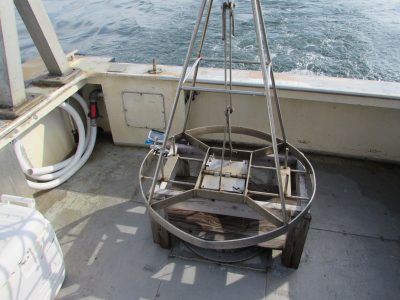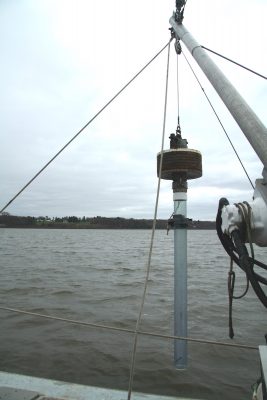Acoustics can provide very accurate representations of the seafloor landscape – both the topography via high-resolution depth data and the nature of the seafloor via the backscatter signal strength. There are, however, a number of factors that can confound these measurements that mandate that actual physical samples of the seafloor be collected for detailed analyses of the sediment grain size. These samples can also be analyzed for a range of compounds from nutrients to heavy metal contaminants. Furthermore, despite the advances in high definition imaging, a picture alone cannot provide information on the rich biodiversity that lives in the sediments of the Sound. There are several sampling devices that have been employed by the Long Island Sound Habitat Mapping teams to provide the fine scale data required to augment the acoustic and imaging systems.
SEABOSS – SEABed Observation and Sampling System
The US Geological Survey’s (USGS) Woods Hole Coastal and Marine Science Center developed the SEABOSS to not only obtain physical samples of the seafloor sediments, but to also image the bottom using high resolution digital still and video cameras. The system is deployed from a research vessel and positioned ~ 1 meter off from the seafloor and allowed to drift with the current to obtain down-looking and oblique imagery. Parallel lasers spaced 10 centimeters apart provide a size reference for the imagery. When the drift transect is complete the system is lowered to the seafloor, tripping a modified Van Veen grab that collects a 30 x 30 x 15 cm sediment sample. The Long Island Sound Mapping and Research Collaborative team sub-divides the sample to provide material for sediment grain size analyses while the remainder is collected and preserved to analyze all of the organisms living within the sample. More information on the SEABOSS is available here.

Sediment Sampler
In addition to the SEABOSS a stand alone modified Van Veen grab was used to collect sediment samples for grain size analyses. A GoPro camera was added to the grab to provide an image of the nature of the seafloor from which the samples were taken.

Sediment Cores
To better understand the long-term history of sedimentation in LIS, sediment coring is essential. Analysis of sediment cores will provide information on various geologic processes through time. The results will significantly improve our understanding of the present sedimentation patterns that will provide insights to guide future decisions for the health of ecosystems. For collecting the sediment cores, we used two systems. One is a gravity corer, consisting of a core head weighing 150 kg and a two-meter long by 11 cm diameter PVC pipe. The core head is equipped with a check valve that maintains a vacuum above the collected sediment. As the name implies, the system descends through the water column and penetrates the sediment by the force of its weight. 
The other system was a hydraulic damped gravity corer, provided by the USGS’ Woods Hole Coastal and Marine Science Center, which allows for the recovery of sandy sediments that are difficult to retain in a normal gravity coring system. The hydraulic corer is a modified gravity corer operated from a quad landing frame that collects 11-cm diameter cores up to 65 cm in length in clear polycarbonate core barrels. In both systems, the clear liners allow visual inspection of the length and quality of sediment core as they are collected. This is essential for deciding to retry to take another core at a core location and to determine, if the surface of the sediment core is intact. Once on deck, sediment cores are capped, sealed with tape, and described. The overlying water is retained in the core barrel to reduce disturbance of the sediment during transportation and storage.
Sediment corer showing weight at the top and 2 meter clear core.